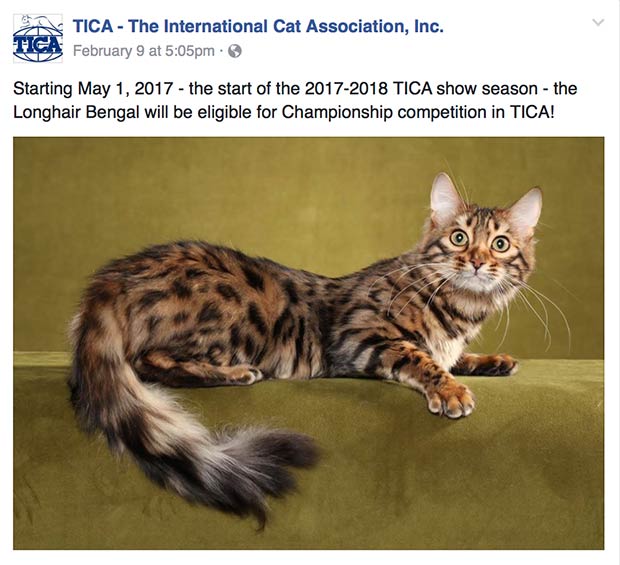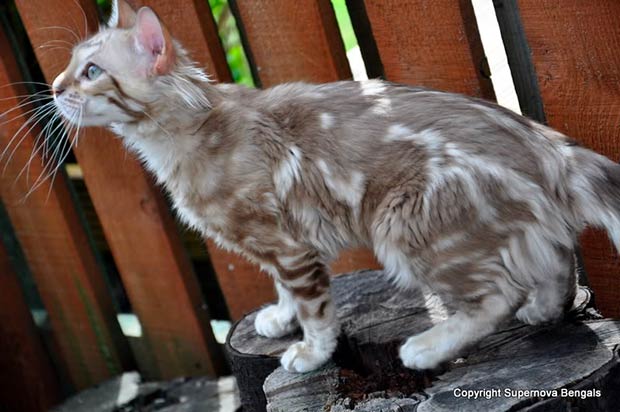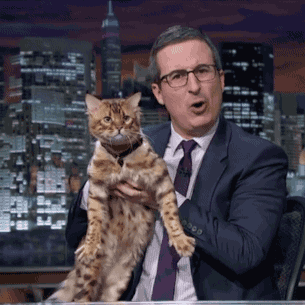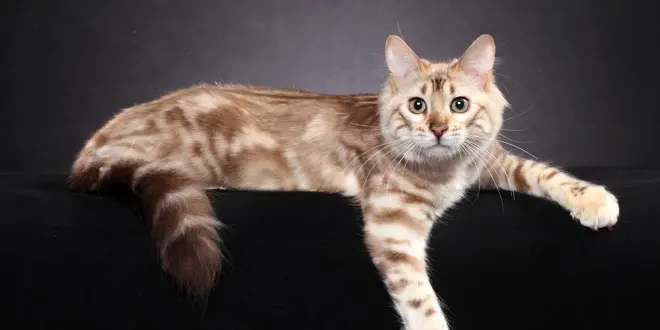Did you know that there are long haired Bengals cat? A variety of this leopard-like breed that boasts a long, silky coat has been named Cashmere by breeders who recognized its extraordinary beauty.
Initially considered as an undesirable trait in Bengal cat breed, longhair gene is now being sought after by breeders.
Although there’s still no evidence to support this claim, with a much softer fur that sheds less than other long-haired breeds, Cashmere Bengals might even have the potential to become one of the rare hypoallergenic longhair breeds.
Overview
Although it might seem that long-haired Bengal cats are some new, exotic breed, the truth is that there have been Bengal kittens with long, soft coats from the beginnings of the Bengal breeding program.
Every so often, a litter of Bengal kittens would have a baby with long hair amongst the traditional, short-haired kitties. These cats were spayed or neutered when they reached maturity, as their coats were considered atypical for the breeding standards.
However, some breeders recognized the beauty and the uniqueness of these fluffy Bengals and decided to develop this unusual trait through breeding. Cashmere Bengals have all the personality traits of the breed, with the exception of the long, silky fur that gives them stunning looks.
History
As I previously mentioned, Cashmere cats have been around as long as the Bengal breed. Although they were initially considered as Bengals with an undesirable trait, Cashmere cats are now intentionally bred, not only as an accepted variety of the breed, but as a new breed altogether.
The breeders in the United States are striving to get these gorgeous felines recognized as long-haired Bengals, an approved, standard variety, whereas European breeders are trying to get Cashmere cats a status of a new, separate breed.
TICA announced that Cashmere cats are eligible for Championship competition, starting May 2017.

The reason why long-haired Bengals exist in the first place is that some Bengals carry a recessive longhair gene. Every now and then. some of the cats that had that gene gave birth to a Cashmere kitten, but it couldn’t be predicted which of the Bengal cats had the recessive longhair gene, as they had the distinct, pelt-like spotted coat.
However, nowadays genetic testing is available and affordable, so it’s easy to determine which Bengals have the potential to have long-haired kittens. By matching parents that both have the recessive longhair gene in their DNA, breeders ensure a Cashmere cat offspring.
Unlike some breeders that use genetic testing to make sure their litters will be up to traditional Bengals standard, others use this method to breed long-haired Bengals exclusively.
Even though long-haired Bengals are a naturally occurring variety of the breed, Cashmere cats are still very rare.
Personality
Although Cashmere cats have a lush, long fur, they are not that different from short-haired Bengal cats. When it comes to their personality, long-haired Bengals have the same traits. They are incredibly intelligent and curious, and often compared to dogs, due to the fact that they are easy to train. Cashmere cats can learn tricks and walk on the leash, same as their short-haired relatives.
Cashmere cats are playful and high-spirited, so expect this fluffy furball to jump around and climb all over your house. One of the characteristic quirks of Bengal cats is true for Cashmere as well, which means you shouldn’t be too surprised if you notice small objects mysteriously vanishing from the place you left them. Hairbands, keys, pencils- it’s all fair game for this long-haired Bengal!
Another interesting trait they share with short-haired Bengals is that they love water, which is unique in the feline world. Some Bengals have even tried their hand sailing and skimboarding, conquering the marine world after realizing that land might not be challenging enough.
But it’s not all just fun and adventures with these leopard-like felines. Long-haired Bengals are quite affectionate and cuddly as well, forming strong bonds with their humans, same as the short-haired Bengals do.
Having all that in mind, it’s safe to say that there is no difference between Bengals and Cashmere cats when it comes to their personality. After all, the only way to make a distinction between these two cats is by comparing the length of their coats!
Appearance
As you’ve probably gathered by now, the most recognizable feature of Cashmere cats is their long, velvety coat. The cats even got the name Cashmere because of their hair, as its silkiness and softness reminded the breeder of this luxurious fiber.
Since this is a naturally occurring variation, there isn’t a standard length of hair that can be expected. The coat can be similar to the one of a Turkish Angora cat, or longer and fluffier, like the fur Maine Coon cats have.
However, it’s important to note that, although long and lush, the Cashmere cat’s fur has a quality that’s closer to Bengals pelt than to other long-haired breeds. Their hair is extremely fine and smooth, and it isn’t prone to matting.
Some breeders of the Cashmere cats even claim that they shed significantly less and that their hair doesn’t need to be brushed. Having in mind how silky and sleek Bengal’s pelt is, it shouldn’t come as a surprise that the long-haired Bengal cats display similar qualities when it comes to their fur.

As far as color and marking go, the Cashmere cats are every bit as stunning and diverse as the Bengal breed.
Their coat can be spotted or rosetted, resembling a miniature, fluffy leopard, or marbled, with dark swirls contrasting their light, silky fur.
Long-haired Bengal’s coat comes in all colors- from brown and gold shades, to snow varieties that have milky, ivory hair complemented by two-toned spots or dark marble pattern.
Common myths & misconceptions
[one_half] [/one_half][one_half_last]When people are not informed enough, which is often the case with new breeds or varieties, they tend to form their opinion on preconceptions that are in no way based on facts.
[/one_half][one_half_last]When people are not informed enough, which is often the case with new breeds or varieties, they tend to form their opinion on preconceptions that are in no way based on facts.
The same happened with Cashmere cats, which were initially considered a mistake by Bengal breeders.[/one_half_last]
Here are the most common myths about long-haired Bengals that need to be debunked, once and for all:
Cashmere cats are not purebred
Cashmere cats are Bengal cats with long hair. They are a product of two Bengal cat parents. What is not purebred about that? It would be like claiming that the Bengal isn’t a pedigree cat, which is ridiculous.
Their long, lush hair is just another unique trait of the Bengals, that’s been overlooked for as long as the breed exists. And it’s not something that makes them less pedigreed, it’s just a trait that gives them some extra flair. (It even rhymes with hair!). And, in case you need some more convincing, TICA announced that Cashmere cats are eligible for Championship competition, starting May 2017.
Cashmere kittens are easy to differ from short-hair ones
Although when they’re adult, Cashmere cats and short-hair Bengal cats can be easily told apart, when they’re still babies, it’s not always that easy. When a litter is brought to the world, it’s hard to tell which one of the kittens is going to be a long-haired Bengal when it grows up.
Usually, the first signs of their lush, thick coat appear when they’re about 6 to 12 weeks old. Even with both Bengal parents carrying the recessive longhair gene, it’s difficult to predict what will the coat of their kittens look like. More often than not, there are kittens with different lengths of the coat in the same litter.
Long-haired Bengals shed more and have tangled hair
The first thing that comes to people’s mind when someone says “long-haired cat” is the picture of a Persian or a Maine Coon cat. Naturally, people then tend to think that Cashmere cats have similar coats, that will need to be brushed regularly to keep the excess hair of their furniture and to prevent their fur from getting matted.
But, Cashmere cats are quite unique in the world of long-haired cat breeds. Their typical Bengal hair is fine, soft and luxurious, and although quite longer than the standard, it still has the same qualities. It’s easy to keep a Cashmere cat perfectly groomed and their coat sleek and tidy.
Long-haired Bengals shed less when compared to other breeds with long-haired coats, and their velvety hair doesn’t mat. Although it’s too early to tell, Cashmere cats might even be as close to hypoallergenic as the short-haired Bengal, which would be amazing news for allergy sufferers.
Cashmere cats have less striking markings
Many people believe that, due to their longer hair, Cashmere cat’s rosettes or spots are less vivid than Bengal’s. This is not necessarily true, as the prominence of the markings varies with each cat. In cases where the fur is longer, with a thicker undercoat, the rosettes might not be as showy as in a short-haired Bengal, but they’re still typical leopard-like spots.
Some long-haired Bengals have beautiful, striking rosettes that make their lush fur even more exotic-looking. Either way, Cashmere cats always come with markings identical to the ones the Bengal cats have. Even if their marble pattern or rosettes aren’t always as bold and dramatic like in short-haired Bengals, their coat is still beautiful and quite striking.
All things considered, whether you’re keen on keeping the standards of the breed or don’t mind the diversity, long-haired Bengals are truly gorgeous. With their newly earned eligibility for TICA Championship, one thing is for sure, we will be seeing more of these fluffy beauties on the catwalk!
[products limit=”3″ columns=”3″ orderby=”id” order=”DESC” visibility=”visible”]




